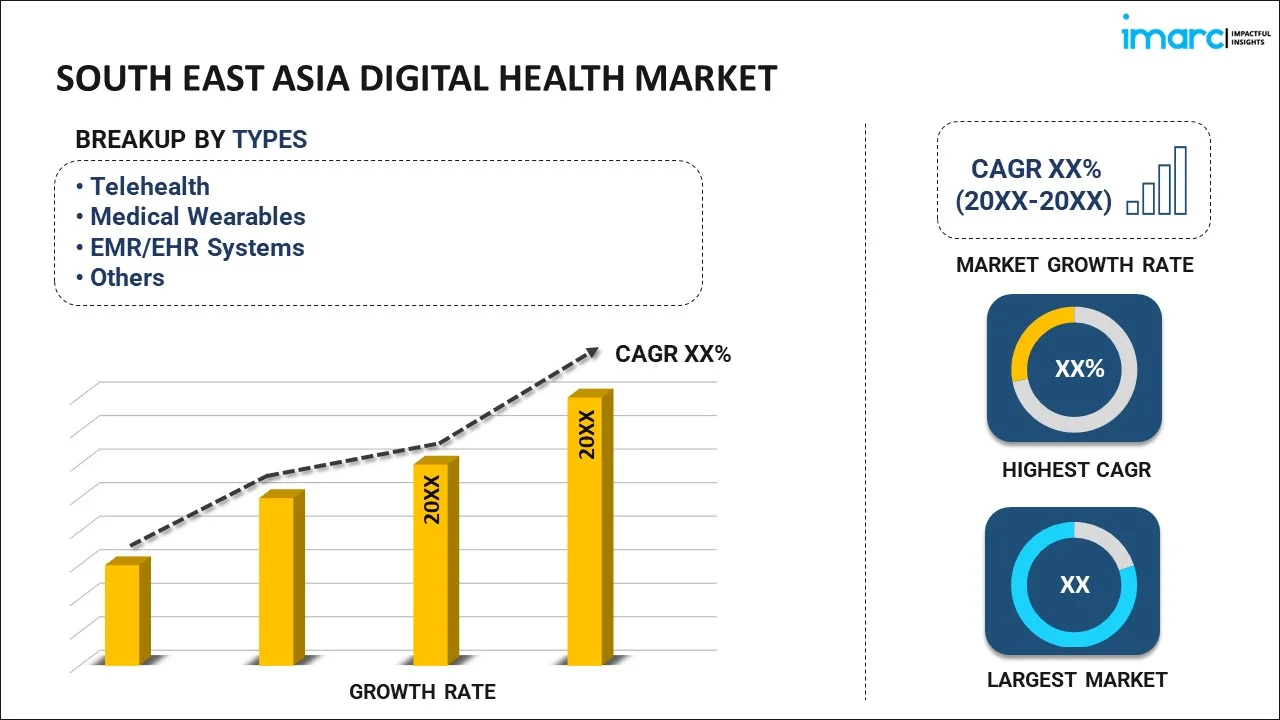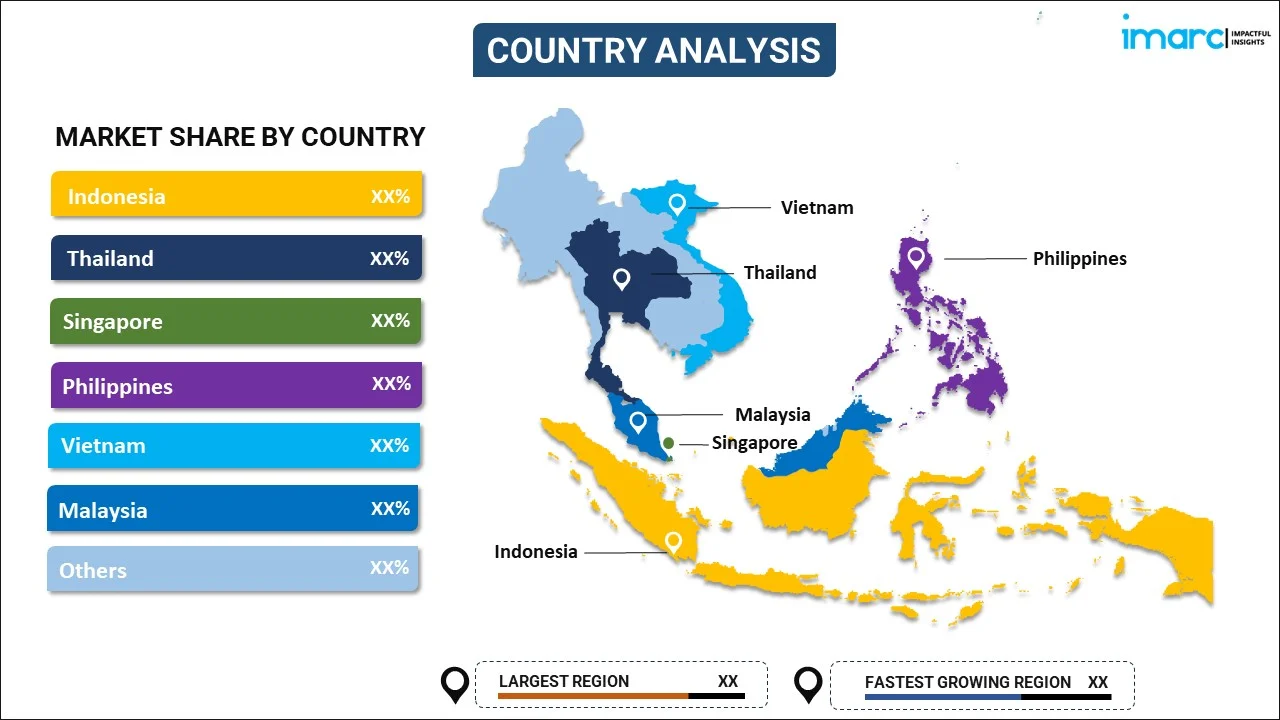
South East Asia Digital Health Market Report by Type (Telehealth, Medical Wearables, EMR/EHR Systems, Medical Apps, Healthcare Analytics, and Others), Component (Software, Hardware, Services), and Country 2025-2033
Market Overview:
South East Asia digital health market size is projected to exhibit a growth rate (CAGR) of 8.45% during 2025-2033. The escalating demand for innovative solutions aimed at enhancing patient care, increasing accessibility, and improving overall healthcare outcomes is primarily augmenting the market growth.
|
Report Attribute
|
Key Statistics
|
|---|---|
|
Base Year
|
2024 |
|
Forecast Years
|
2025-2033
|
|
Historical Years
|
2019-2024
|
| Market Growth Rate (2025-2033) | 8.45% |
Digital health involves incorporating digital technologies into healthcare practices and services to enhance the delivery and management of healthcare. It encompasses a diverse range of applications, including telemedicine, mobile health (mHealth) apps, wearable devices, electronic health records (EHRs), remote patient monitoring, and health data analytics. The introduction of digital health has transformed the healthcare industry by empowering patients to actively engage in managing their health and enabling healthcare providers to deliver more personalized and efficient care. A crucial component of digital health is telemedicine, enabling patients to remotely consult with healthcare professionals through video conferencing or virtual platforms. This proves particularly advantageous in providing medical services to individuals in rural or underserved areas, overcoming geographical barriers to healthcare. Additionally, the popularity of mHealth apps and wearable devices has surged, facilitating health tracking, medication adherence, and lifestyle management, fostering a proactive approach to health and wellness.
South East Asia Digital Health Market Trends:
The South East Asia digital health market is undergoing a transformative evolution, revolutionizing healthcare delivery through the integration of digital technologies. Additionally, the adoption of digital health technologies in the region is reshaping traditional healthcare practices, fostering a more patient-centric and efficient system. Besides this, telemedicine, a key component of digital health, has emerged as a transformative force, allowing individuals to access healthcare remotely through virtual consultations and video conferencing. It proves particularly beneficial in addressing healthcare gaps in rural and underserved areas, overcoming geographical constraints. Furthermore, mHealth apps and wearable devices are gaining significant traction in South East Asia, providing users with tools for health tracking, medication adherence, and lifestyle management. These technologies empower individuals to take a proactive role in managing their health and well-being. Furthermore, the market is driven by factors such as increasing smartphone penetration, rising health awareness, and the need for efficient healthcare delivery in diverse and geographically dispersed populations. The South East Asia digital health market is poised for continued growth, contributing to the region's efforts in advancing healthcare accessibility and outcomes through technological innovation in the coming years.
South East Asia Digital Health Market Segmentation:
IMARC Group provides an analysis of the key trends in each segment of the market, along with forecasts at the regional and country levels for 2025-2033. Our report has categorized the market based on type and component.
Type Insights:

- Telehealth
- Medical Wearables
- EMR/EHR Systems
- Medical Apps
- Healthcare Analytics
- Others
The report has provided a detailed breakup and analysis of the market based on the type. This includes telehealth, medical wearables, EMR/HER systems, medical apps, healthcare analytics, and others.
Component Insights:
- Software
- Hardware
- Services
A detailed breakup and analysis of the market based on the component have also been provided in the report. This includes software, hardware, and services.
Country Insights:

- Indonesia
- Thailand
- Singapore
- Philippines
- Vietnam
- Malaysia
- Others
The report has also provided a comprehensive analysis of all the major regional markets, which include Indonesia, Thailand, Singapore, Philippines, Vietnam, Malaysia, and Others.
Competitive Landscape:
The market research report has also provided a comprehensive analysis of the competitive landscape in the market. Competitive analysis such as market structure, key player positioning, top winning strategies, competitive dashboard, and company evaluation quadrant has been covered in the report. Also, detailed profiles of all major companies have been provided.
South East Asia Digital Health Market Report Coverage:
| Report Features | Details |
|---|---|
| Base Year of the Analysis | 2024 |
| Historical Period | 2019-2024 |
| Forecast Period | 2025-2033 |
| Units | Million USD |
| Scope of the Report | Exploration of Historical and Forecast Trends, Industry Catalysts and Challenges, Segment-Wise Historical and Predictive Market Assessment:
|
| Types Covered | Telehealth, Medical Wearables, EMR/EHR Systems, Medical Apps, Healthcare Analytics, Others |
| Components Covered | Software, Hardware, Services |
| Countries Covered | Indonesia, Thailand, Singapore, Philippines, Vietnam, Malaysia, Others |
| Customization Scope | 10% Free Customization |
| Post-Sale Analyst Support | 10-12 Weeks |
| Delivery Format | PDF and Excel through Email (We can also provide the editable version of the report in PPT/Word format on special request) |
Key Questions Answered in This Report:
- How has the South East Asia digital health market performed so far and how will it perform in the coming years?
- What has been the impact of COVID-19 on the South East Asia digital health market?
- What is the breakup of the South East Asia digital health market on the basis of type?
- What is the breakup of the South East Asia digital health market on the basis of component?
- What are the various stages in the value chain of the South East Asia digital health market?
- What are the key driving factors and challenges in the South East Asia digital health?
- What is the structure of the South East Asia digital health market and who are the key players?
- What is the degree of competition in the South East Asia digital health market?
Key Benefits for Stakeholders:
- IMARC’s industry report offers a comprehensive quantitative analysis of various market segments, historical and current market trends, market forecasts, and dynamics of the South East Asia digital health market from 2019-2033.
- The research report provides the latest information on the market drivers, challenges, and opportunities in the South East Asia digital health market.
- Porter's five forces analysis assist stakeholders in assessing the impact of new entrants, competitive rivalry, supplier power, buyer power, and the threat of substitution. It helps stakeholders to analyze the level of competition within the South East Asia digital health industry and its attractiveness.
- Competitive landscape allows stakeholders to understand their competitive environment and provides an insight into the current positions of key players in the market.
Need more help?
- Speak to our experienced analysts for insights on the current market scenarios.
- Include additional segments and countries to customize the report as per your requirement.
- Gain an unparalleled competitive advantage in your domain by understanding how to utilize the report and positively impacting your operations and revenue.
- For further assistance, please connect with our analysts.
 Inquire Before Buying
Inquire Before Buying
 Speak to an Analyst
Speak to an Analyst
 Request Brochure
Request Brochure
 Request Customization
Request Customization




.webp)




.webp)












